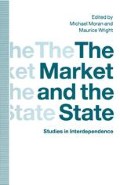Abstract
This chapter begins with three clarifications. First, the markets to which it refers are electoral markets, and, within these markets, the pattern of competition with which it is concerned is inter-party competition. As is evident, parties will compete with one another when they have a market in which to compete, that is, when there are voters in competition; and the assumption which underlies the chapter, albeit guardedly so, is that the actual extent of inter-party competition, and the competitiveness of parties, is at least in part a function of the relative size of the electoral market. As the market expands, therefore, or as the number of voters in competition increases, parties are likely to become more competitive. As the market contracts, on the other hand, and as the number of voters in competition declines, parties are likely to become less competitive.
Access this chapter
Tax calculation will be finalised at checkout
Purchases are for personal use only
Preview
Unable to display preview. Download preview PDF.
Notes
See Roberto D’Alimonte, ‘Democrazia e Competizione’, Rivista Italiana di Scienza Politico 19, 1 (1989) 115–33.
See Giacomo Sani and Giovanni Sartori, ‘Polarization, Fragmentation and Competition in Western Democracies’, in Hans Daalder and Peter Mair (eds), Western European Party Systems: Continuity and Change (London: Sage, 1983, pp. 307–40)
and Ruud Koole and Philipvan Praag, ‘Electoral Competition in a Segmented Society: Campaign Strategies and the Importance of Elite Perceptions’, European Journal of Political Research 18, 1 (1990) 51–70.
See Stefano Bartolini and Peter Mair, Identity, Competition, and Electoral Availability: The Stabilization of European Electorates, 1885–1985 (Cambridge: Cambridge University Press, 1990).
Giovanni Sartori, ‘From the Sociology of Politics to Political Sociology’, in S. M. Lipset (ed), Politics and the Social Sciences (New York: Oxford University Press, 1969), pp. 65–100.
See Sigmund Neumann, ‘Toward a Comparative Study of Political Parties’, in Sigmund Neumann (ed.) Modern Political Parties (Chicago: University of Chicago Press, 1956), pp. 404–5.
Otto Kirchheimer, “The Transformation of the Western European Party Systems’, in Joseph LaPalombara and Myron Weiner (eds), Political Parties and Political Development. (Princeton: Princeton University Press, 1966), p. 184.
S. M. Lipset and Stein Rokkan, ‘Cleavage Structures, Party Systems and Voter Alignments: an Introduction’, in S. M. Lipset and Stein Rokkan (eds) Party Systems and Voter Alignments. (New York: The Free Press, 1967), pp. 50–1.
See Stefano Bartolini, ‘Il Mutamento del Sistema Partitico Francese’, Il Mulino 30 (1981) 169–219.
See Peter Mair, The Changing Irish Party System: Organization, Ideology and Electoral Competition (London: Pinter, 1987), pp. 86–9.
See Arend Lijphart, ‘Typologies of Democratic Systems’, Comparative Politics 1, 1 (1968) 3–44, and his Democracy in Plural Societies: A Comparative Exploration (New Haven: Yale University Press, 1977).
Lijphart, Democracy in Plural Societies, ch. 3; See also Hans Daalder, ‘The Consociational Democracy Theme’, World Politics 26, 4 (1974) 604–21.
See Adriano Pappalardo, ‘The Conditions for Consociational Democracy: A Logical and Empirical Critique’, European Journal of Political Research 9, 4 (1981) 365–90.
Mean electoral volatility is calculated according to the formula proposed by Mogens Pedersen, ‘The Dynamics of European Party Systems: Changing Patterns of Electoral Volatility’, European Journal of Political Research 7, 1 (1979) 1–26, and offers a useful index of the aggregate electoral change from one election to the next, and hence also offers a useful summary indicator of the potential openness of the electoral market. The index is calculated by measuring the sum of the percentage gains of all winning parties in an election (or the sum of the losses, which is the same figure), and has a theoretical range running from 0 (all parties retain the same share of the vote as in the previous election) to 100 (all existing parties lose all their votes to wholly new parties). The figures cited in this paper are drawn from Bartolini and Mair, Identity, Competition and Electoral Availability.
See Ian McAllister, The Northern Ireland Social and Democratic and Labour Party (London: Macmillan, 1977), p. 16
See Gabriel A. Almond, ‘Comparative Political Systems’, Journal of Politics 18, 3 (1956) 391–409, and Lijphart, ‘Typologies’, op. cit.
See Peter J. Katzenstein, Small States in World Markets: Industrial Policy in Europe (Ithaca: Cornell University Press, 1985)
See Stefano Bartolini, ‘The European Left Since World War I: Size, Composition and Electoral Development’, in Daalder and Mair (eds), Western European Party Systems: Continuity and Change, pp. 139–76 and Adam Przeworski and John Sprague, Paper Stones: A History of Electoral Socialism (Chicago: University of Chicago Press, 1986). Note also the emphasis by Katzenstein, Small States, on the importance of proportional electoral formulae and the political fragmentation of the right.
See also Stein Rokkan, ‘Towards a Generalized Concept of Verzuiling’ Political Studies 25, 4 (1977) 563–70.
As in the Netherlands and Denmark, for example: see Galen A. Irwin and J. J. M. van Holsteyn, ‘Decline of the Structured Model of Electoral Competition’, in Hans Daalder and Galen A. Irwin (eds), Politics in the Netherlands: How Much Change? (London: Cass, 1989), pp. 21–41,
and Jan Sundberg, ‘Explaining the Basis of Declining Party Membership in Denmark: a Scandinavian Comparison’, Scandinavian Political Studies 10, 1 (1987) 17–38.
Editor information
Editors and Affiliations
Copyright information
© 1991 Michael Moran and Maurice Wright
About this chapter
Cite this chapter
Mair, P. (1991). Electoral Markets and Stable States. In: Moran, M., Wright, M. (eds) The Market and the State. Palgrave Macmillan, London. https://doi.org/10.1007/978-1-349-21619-2_7
Download citation
DOI: https://doi.org/10.1007/978-1-349-21619-2_7
Publisher Name: Palgrave Macmillan, London
Print ISBN: 978-1-349-21621-5
Online ISBN: 978-1-349-21619-2
eBook Packages: Palgrave Political & Intern. Studies CollectionPolitical Science and International Studies (R0)

